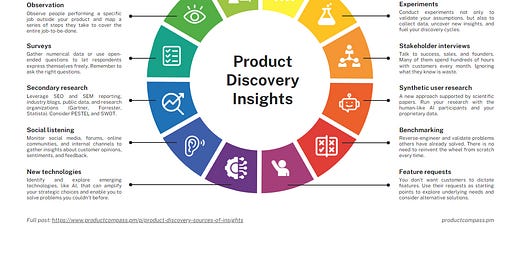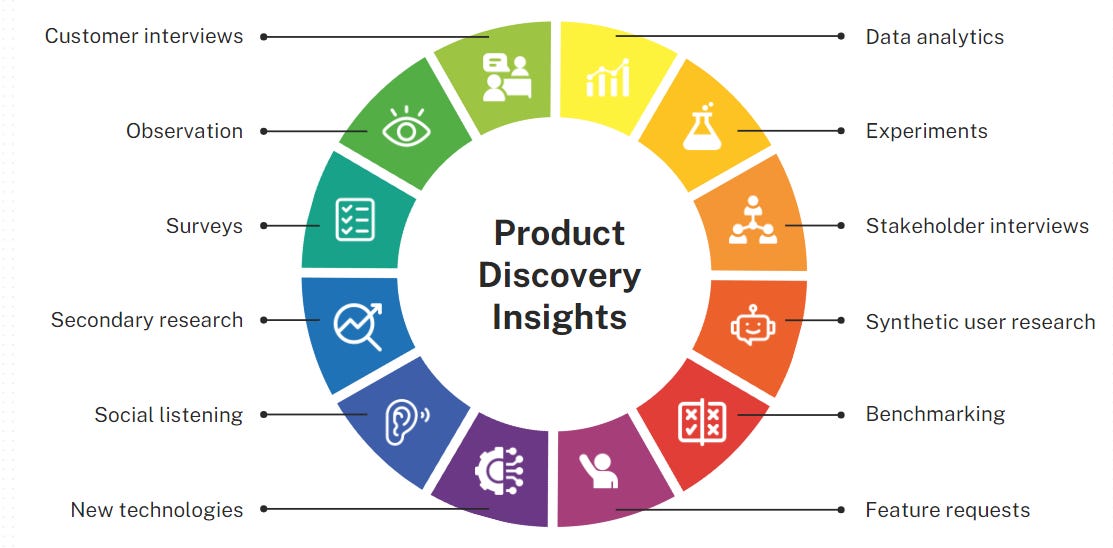12 Proven Sources of Insights to Fuel Your Product Discovery
Regularly talking to customers is essential for any product team. But true innovation comes from gathering insights from multiple sources.
Hi, Paweł here. Welcome to the free archived edition of The Product Compass.
Each week, I share actionable insights and resources for PMs. Here’s what you might have missed:
Assumption Prioritization Canvas: How to Identify And Test The Right Assumptions
Kano Model: How to Delight Your Customers Without Becoming a Feature Factory
Consider subscribing and upgrading your account for the full experience:
Talking to your customers regularly is the most critical activity for any product team.
In her book Continuous Discovery Habits, Teresa Torres emphasizes that the "Product Trio” must build a habit of interviewing customers at least weekly.
I couldn’t agree more.
The value you can capture for the business comes from the value you create for others. This idea is at the heart of the North Star Framework and the key to sustainable growth.
But while customer interviews are crucial, they might not be enough to spark real innovation. Product teams I work with draw from multiple sources of insights to explore the problem space in depth.
So, in this post, I’ll share 12 proven ways to fuel your discovery.
1. Customer interviews
Customer interviews are powerful for uncovering unmet needs, pain points, and hidden motivations — the “why” behind customer behaviors.
People are biased, so we need to remember to focus on asking about specific situations and facts rather than opinions.
My favorite approach is the storytelling technique. Start with an opening question like, “Can you tell me about a specific time when [something happened]?” and then encourage customers to walk you through their experiences step by step.
For more details, check out The Ultimate Guide to Research Interviews.
2. Observation
Observing customers in their natural environment provides a unique perspective, often revealing insights beyond what customers can articulate themselves.
Aim to map a series of steps a customer takes to complete a specific job-to-be-done. As Tony Ulwick explains in Jobs to be Done, customers prefer to complete the entire job within a single product.
Let that sink in.
In my experience, observation becomes even more powerful when combined with User Journey Mapping, which enables you to visualize different aspects of the process customers go through.
3. Surveys
Surveys are invaluable for collecting data at scale. I often combine open-ended questions that can reveal deeper motivations and opinions with closed-ended questions that help me quantify trends.
When crafting survey questions, ensure that each one serves a clear purpose, is easy to understand, and is relevant to your audience.
I love this quote:
“Asking one person the right question gets better results than asking 10,000 people the wrong question” - Carolyn Jarrett, Surveys That Work
To learn more, check out The Ultimate Guide to Effective Customer Surveys.
4. Secondary research
Secondary research is a cost-effective way to leverage existing data. Critically, it doesn't replace collecting Your Own Data (YODA).
When using SEO and SEM tools like Moz, SEMrush, or Ahrefs, look beyond just traffic and ranking data. Dive deeper into analyzing content strategies, backlink profiles, and keyword opportunities to refine your product positioning and messaging.
For new products, consider whether you’re entering the right industry by applying frameworks like PESTEL and SWOT analysis.
For more insights, check out Market Research: Advanced Techniques.
5. Social listening
Social listening goes beyond just tracking mentions of your brand or product on social media, forums, and online communities. It's about understanding the broader conversation around your industry, competitors, and related topics.
In most cases, you can automate this process to quickly analyze vast amounts of unstructured data. For example, we previously discussed a ready-to-use ChatGPT prompt for automating sentiment analysis.
Bonus tip: Similarly, you can “listen” to what customers say in your internal calls and support channels.
Keep reading with a 7-day free trial
Subscribe to The Product Compass to keep reading this post and get 7 days of free access to the full post archives.




